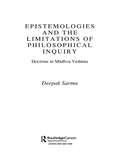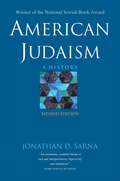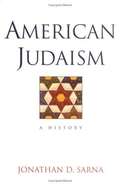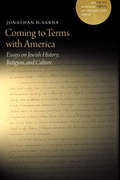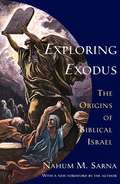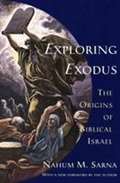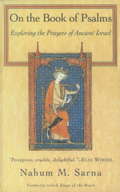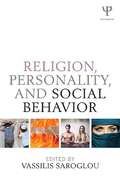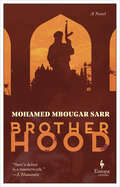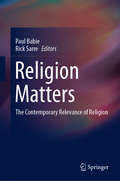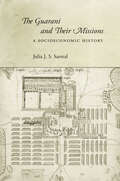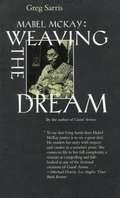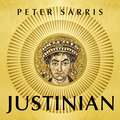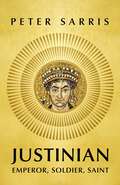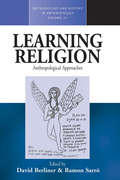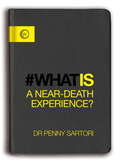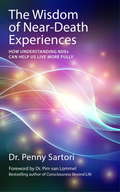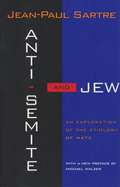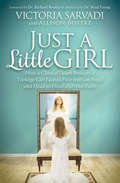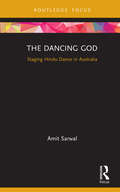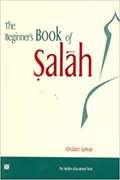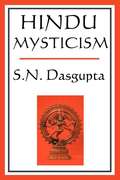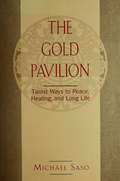- Table View
- List View
Epistemologies and the Limitations of Philosophical Inquiry: Doctrine in Madhva Vedanta (Routledge Hindu Studies Series)
by Deepak SarmaDeepak Sarma explores the degree to which outsiders can understand and interpret the doctrine of the Màdhva school of Vedànta. The school is based on insider epistemology which is so restrictive that few can learn its intricate doctrines. This book reveals the complexity of studying traditions based on insider epistemologies and encourages its audience to ponder both the value and the hazards of granting any outsider the authority and opportunity to derive important insights into a tradition as an insider.
The American Jewish Experience (2nd Edition)
by Jonathan D. SarnaThe second edition of this textbook constitutes a substantial revision designed to take advantage of recent scholarship in the field. Nine new pieces have been added, requiring me to delete seven excellent chapters from the earlier edition for which room could no longer be found.
American Judaism: A History, Second Edition
by Jonathan D. SarnaJonathan D. Sarna’s award-winning American Judaism is now available in an updated and revised edition that summarizes recent scholarship and takes into account important historical, cultural, and political developments in American Judaism over the past fifteen years. Praise for the first edition: “Sarna . . . has written the first systematic, comprehensive, and coherent history of Judaism in America; one so well executed, it is likely to set the standard for the next fifty years.”—Jacob Neusner, Jerusalem Post “A masterful overview.”—Jeffrey S. Gurock, American Historical Review “This book is destined to be the new classic of American Jewish history.”—Norman H. Finkelstein, Jewish Book World Winner of the 2004 National Jewish Book Award/Jewish Book of the Year
American Judaism: A History
by Jonathan D. SarnaSarna, a preeminent scholar of American Judaism (he's affiliated with Brandeis University), chronicles events, personalities, and attitudes pertaining to Jews, as well as attitudes held by Jews themselves, in the United States over a period of 350 years. He weaves the history of a people present in the United States since early colonial daysmarginalized in many ways and always worried about survivalinto the context of America's political, social, and religious life. Relevant to non-Jewish as well as Jewish communities, the themes of evolving cultural and personal identities, assimilation, and revitalization are core in both American history and contemporary American life. This thoughtful and engaging work will attract a wide scholarly and lay audience. Annotation ©2004 Book News, Inc. , Portland, OR (booknews. com)
Coming to Terms with America: Essays on Jewish History, Religion, and Culture (A JPS Scholar of Distinction Book)
by Jonathan D. SarnaComing to Terms with America examines how Jews have long &“straddled two civilizations,&” endeavoring to be both Jewish and American at once, from the American Revolution to today. In fifteen engaging essays, Jonathan D. Sarna investigates the many facets of the Jewish-American encounter—what Jews have borrowed from their surroundings, what they have resisted, what they have synthesized, and what they have subverted. Part I surveys how Jews first worked to reconcile Judaism with the country&’s new democratic ethos and to reconcile their faith-based culture with local metropolitan cultures. Part II analyzes religio-cultural initiatives, many spearheaded by women, and the ongoing tensions between Jewish scholars (who pore over traditional Jewish sources) and activists (who are concerned with applying them). Part III appraises Jewish-Christian relations: &“collisions&” within the public square and over church-state separation. Originally written over the span of forty years, many of these essays are considered classics in the field, and several remain fixtures of American Jewish history syllabi. Others appeared in fairly obscure venues and will be discovered here anew. Together, these essays—newly updated for this volume—cull the finest thinking of one of American Jewry&’s finest historians.
Exploring Exodus: The Origins of Biblical Israel
by Nahum M. SarnaSarna examines the distinctiveness of the Exodus narrative in light of ancient Near Eastern history and contemporaneous cultures--Egyptian, Assyrian, Canaanite, and Babylonian. In a new Foreword to the 1996 edition, Sarna takes up the debate over whether the exodus from Egypt really happened, clarifying the arguments on both sides and drawing us back to the uniqueness and enduring significance of biblical text.
Exploring Exodus: The Origins of Biblical Israel
by Nahum M. SarnaSarna examines the distinctiveness of the Exodus narrative in light of ancient Near Eastern history and contemporaneous cultures--Egyptian, Assyrian, Canaanite, and Babylonian. In a new Foreword to the 1996 edition, Sarna takes up the debate over whether the exodus from Egypt really happened, clarifying the arguments on both sides and drawing us back to the uniqueness and enduring significance of biblical text.
On the Book of Psalms: Exploring the Prayers of Ancient Israel
by Nahum M. SarnaThis book is the result of a lifetime of study of the Hebrew Bible by a mature scholar whose love of the Tanakh, and especially of the Psalter, shines through on every page.
Religion, Personality, and Social Behavior
by Vassilis SaroglouPsychological interest in religion, in terms of both theory and empirical research, has been constant since the beginning of psychology. However, since the beginning of the 21st Century, partially due to important social and political events and developments, interest in religion within personality and social psychology has increased. This volume reviews the accumulated research and theory on the major aspects of personality and social psychology as applied to religion. It provides a high quality integrative, systematic, and rigorous review of that work, with a focus on topics that are both central in personality and social psychology and have allowed for the accumulation of solid and replicated and not impressionist knowledge on religion. The contributors are renowned researchers in the field who offer an international perspective that is both illuminating, yet neutral, with respect to religion. The volume’s primary audience are academics, researchers, and advanced students in social psychology, but it will also interest those in sociology, political sciences, and anthropology.
Brotherhood: A Novel
by Mohamed Mbougar SarrThe Senegalese author’s prize-winning novel explores brutality and resistance in a fictional North African city gripped by a fundamentalist regime.Under the regime of the so-called Brotherhood, two young people are publicly executed for having loved each other. In response, their mothers begin a secret correspondence, their only outlet for the grief they share.Spurred by The Brotherhood’s escalating brutality, a band of intellectuals seeks to foment rebellion by publishing an underground newspaper. Menawhile, the regime’s leader undertakes a personal crusade to find the responsible parties, and bring them to his own sense of justice.In Brotherhood, Mbougar Sarr explores how resistance and heroism can often give way to cowardice, all while giving voice to the personal struggles of each of his characters as they try to salvage the values they hold most dear.Winner of the French Voices Grand Prize, Prix Ahmadou Kourouma, and Grand Prix du Roman Métis
Religion Matters: The Contemporary Relevance of Religion
by Rick Sarre Paul BabieThis book draws together leaders in science, the health sciences, the humanities, and the social sciences to investigate the role of religion, its meaning and relevance, for their area of specialization. It provides a much-needed fresh perspective on the way in which religion operates within the modern, neo-liberal world. The book approaches the topic by way of a critical engagement between religion, broadly defined, and the individual disciplines in which each of the contributors is expert. Rather than simply taking the dogmatic position that religion offers something to every possible discipline, each of the chapters in this collection addresses the question: is there something that religion can offer to the discipline in question? That is the value of the book – it takes a truly critical stance on the place of religion in contemporary society.
The Guaraní and Their Missions
by Julia J. S. SarrealThe thirty Guaraní missions of the Río de la Plata were the largest and most prosperous of all the Catholic missions established throughout the frontier regions of the Americas to convert, acculturate, and incorporate indigenous peoples and their lands into the Spanish and Portuguese empires. But between 1768 and 1800, the mission population fell by almost half and the economy became insolvent. This unique socioeconomic history provides a coherent and comprehensive explanation for the missions' operation and decline, providing readers with an understanding of the material changes experienced by the Guaraní in their day-to-day lives. Although the mission economy funded operations, sustained the population, and influenced daily routines, scholars have not focused on this important aspect of Guaraní history, primarily producing studies of religious and cultural change. This book employs mission account books, letters, and other archival materials to trace the Guaraní mission work regime and to examine how the Guaraní shaped the mission economy. These materials enable the author to poke holes in longheld beliefs about Jesuit mission management and offer original arguments regarding the Bourbon reforms that ultimately made the missions unsustainable.
Mabel McKay: Weaving the Dream
by Greg SarrisIn this wise book, Greg Sarris weaves together stories from the life of Mabel McKay, a world-renowned Pomo basket weaver and medicine woman. As his mentor and teacher, Mabel McKay told Sarris many of the stories that inspired Grand Avenue, his acclaimed book of short fiction and the basis for an HBO film of the same name.
Justinian: Emperor, Soldier, Saint
by Professor Peter SarrisThe definitive life story of the Roman Emperor who shaped modern times.In this groundbreaking new biography of Justinian, Peter Sarris gives us an intimate insight into both the Emperor and the man. We meet a man who from the humblest beginnings, rose to become ruler of much of the known world achieving an almost god-like status. An emperor who infused even the most mundane tasks with spiritual and religious significance. A gifted administrator obsessed with detail. A middle aged lover who fell for a dancing girl and changed the law so he could marry her, ruling with Empress Theodora by his side for over twenty years. A brilliant military strategist who was never a soldier. The challenges he faced - climate change, battles over culture and identity, the first recorded global pandemic -and many of the solutions he found to address them still resonate with us today. And his legacy remains all around us, in the massive building programme of which the most beautiful manifestation is surely Hagia Sophia; in our legal systems through the codification of the Corpus juris civilis; and in our culture and history by making a fundamental contribution to both the formation of Christendom and the emergence of Islam. In this tour de force Peter Sarris shows us that in all his complexity and contradictions Justinian was, in many ways, a very modern Emperor.(P)2023 Hodder & Stoughton Limited
Justinian: Emperor, Soldier, Saint
by Professor Peter Sarris'A majestic, sparkling account of one of the most important rulers in history . . . this is modern history writing at its finest' Peter Frankopan'Superb and gripping. Epic historical biography that brings the emperor to life . . . filled with new ideas and revelations' Simon Sebag Montefiore'Effortlessly erudite, lucidly written, with a sharp eye for the telling detail, Sarris has written the great biography of the greatest of the Byzantine emperors' Rory StewartIn this groundbreaking new biography of Justinian, Peter Sarris gives us an intimate insight into both the Emperor and his times. We meet a man who from the humblest beginnings, rose to become ruler of much of the known world achieving an almost god-like status. An emperor who infused even the most mundane tasks with spiritual and religious significance. A gifted administrator obsessed with detail. A middle aged lover who fell for a dancing girl and changed the law so he could marry her, ruling with Empress Theodora by his side for over twenty years. A brilliant military strategist who was never on the frontline. The challenges he faced - climate change, battles over culture and identity, the first recorded global pandemic -and many of the solutions he found to address them still resonate with us today. And his legacy remains all around us, in the massive building programme of which the most beautiful manifestation is surely Hagia Sophia; in our legal systems through the codification of the Corpus juris civilis; and in our culture and history by making a fundamental contribution to both the formation of Christendom and the emergence of Islam. In this tour de force Peter Sarris shows us that in all his complexity and contradictions Justinian was, in many ways, a very modern Emperor.
Learning Religion
by Ramon Sarro David BerlinerAs we enter the 21st century, it becomes increasingly difficult to envisage a world detached from religion or an anthropology blind to its study. Yet, how people become religious is still poorly studied. This volume gathers some of the most distinguished scholars in the field to offer a new perspective for the study of religion, one that examines the works of transmission and innovation through the prism of learning. They argue that religious culture is socially and dynamically constructed by agents who are not mere passive recipients but engaged in active learning processes. Finding a middle way between the social and the cognitive, they see learning religions not as a mechanism of "downloading" but also as a social process with its relational dimension.
What Is A Near Death Experience?
by Dr Penny SartoriDeath is the only certainty in life yet many people shy away from thinking about it until something drastic happens such as the diagnosis of a life-threatening illness, or the sudden death of a loved one, which can throw us into turmoil. Yet, paradoxically, contemplating death and the frequently-experienced phenomenon of near-death experiences (NDEs) - which are so little recognised and supported within the traditional medical environment - can really help alter our relationship with death and release us from the fear that often surrounds it.After an insightful introduction about why the subject of NDEs is so worth exploring, each chapter in this book addresses a key question: What are the Characteristics of an NDE, and are there different types? Are all NDE experiences pleasant, or can some be distressing? Who has NDEs and under what circumstances do they occur? How do they affect the people who have them, and how can this change their lives? How can NDEs be scientifically explained - aren't they just hallucinations? What can we learn from NDEs, and can they change our attitude to life and death? Can a greater understanding of NDEs lead to an evolution in our consciousness and an enhanced sense of spirituality?As such, this book really brings readers on an exploratory journey through the world of NDEs, challenging preconceptions about what they are and the impact they can have, encouraging us to accept and feel empowered by death, rather than living in fear of it, and giving us useful insights about life along the way.From the Trade Paperback edition.
Wisdom of Near-Death Experiences
by Penny Sartori Dr Pim Van LommelPenny Sartori is a registered nurse who began researching Near Death Experiences (NDEs) in 1995 after one of her long-term intensive care patients begged her to let him die in peace. The event shook her deeply and eventually led her to enroll in a PhD program to research NDEs. The findings, along with the profound spiritual lessons that she has gleaned from her work, are published here. During her academic work, Sartori studied three samples of ICU patients during a five year period. The first consisted of 243 patients from the first year of data collection who survived their ICU experience. Of those, two experienced an NDE, and two an out-of-body experience (OBE). The second cohort consisted of survivors of cardiac arrest during the five year period. Of those, 39 patients (or 18%) experienced an NDE. The third cohort consisted of all the patients who experienced an NDE during the five year period. Their stories are captured in her new book. One patient in particular, patient number 10, stands out for Sartori. "He was in bad condition," she says. "When we put him into bed he was unconscious and unresponsive. Later he reported an OBE. He was accurately able to tell us which doctor was in the room and what he had said while he was unconscious. He claimed to have met his deceased father and a Jesus-like figure. But the most extraordinary part was that afterwards he was able to use his hand, which had been paralyzed since birth. There is no medical explanation for how that healing occurred. " When asked about the biggest takeaway from her research, Sartori says, "In medicine, we're trained to believe that the brain gives rise to consciousness. My research into NDEs has made me question this prevailing paradigm, which admittedly is very widespread. The most important lesson for me has been a deeper appreciation for death and a whole lot less fear and anxiety about it. " In addition to detailing dozens of case studies, the book also discusses childhood NDEs, differences in NDEs among different cultures, and the after-effects of NDEs--one of which is the inability, in some patients, to wear a wrist-watch
Anti-Semite and Jew: An Exploration of the Etiology of Hate
by Jean-Paul Sartre George BeckerA classic study from the author of philosophy which is a must-read for any serious student of the aetiology of hatred.
Just a Little Girl: How a Clinical Death Brought a Teenage Girl Face-to-Face with an Angel and Head-to-Toe with Her Faith
by Victoria Sarvadi Allison BottkeWhen eighteen-year- old Victoria dies in the ICU and encounters an angel that gives her aprophetic mandate from God, her insatiable quest for spiritual enlightenment begins. As compelling as any contemporary novel, this dramatic and inspiring true story is a roller-coaster ride through supernatural experience, denominational enlightenment, and a teenage marriage that not only survives the loss of a child but thrives through unbeatable odds. Shining a fresh light on the theology of a Jewish Jesus, the author deftly weaves the history of the Christian faith from its genesis of the first century to the present-day Greco-Roman Christianityall the while giving us an up close and personal glimpse of an extraordinary life. A devoted wife, mother of six, and grandmother of nineteen, Victoria refuses to succumb to age and limitations. Far from Just a Little Girl, Victoria Sarvadis unconventional journey from teenage motherhood to Hebraic scholar and teacher will captivate and consume you from start to finish.,
The Dancing God: Staging Hindu Dance in Australia
by Amit SarwalThe Dancing God: Staging Hindu Dance in Australia charts the sensational and historic journey of de-provincialising and popularising Hindu dance in Australia. In the late nineteenth and early twentieth centuries, colonialism, orientalism and nationalism came together in various combinations to make traditional Hindu temple dance into a global art form. The intricately symbolic Hindu dance in its vital form was virtually unseen and unknown in Australia until an Australian impresario, Louise Lightfoot, brought it onto the stage. Her experimental changes, which modernised Kathakali dance through her pioneering collaboration with Indian dancer Ananda Shivaram, moved the Hindu dance from the sphere of ritualistic practice to formalised stage art. Amit Sarwal argues that this movement enabled both the authentic Hindu dance and dancer to gain recognition worldwide and created in his persona a cultural guru and ambassador on the global stage. Ideal for anyone with an interest in global dance, The Dancing God is an in-depth study of how a unique dance form evolved in the meeting of travellers and cultures.
The Beginner's Book Of Salah
by Ghulam Sarwar Muslim Educational Trust StaffThe important pillar of Islam, Salah (daily prayers) is explained in detail in this invaluable book. The aim is to acquaint young Muslims with the knowledge necessary to be able to perform this vital act of worship. The author sets out to achieve this with the use of diagrams, pictures, Arabic text and English transliteration. The intended age range is 10-16, although older people may also find it a useful aid to learning. This work, while suitable for young Muslims, is ideal for adults as a summary of the important features of salah (daily Muslim prayer). Attractively laid out with charts and pictures, the Arabic text is transliterated. The Children's book of Salah explains the necessary details of the second basic duty of Islam-As-Salah. It aims to acquaint young Muslims with the knowledge of how to perform Salah. In addition to the five daily Salah, there are chapters on Salah for special occasions, eleven Surahs of the Qur'an, and a selection of Qur'anic verses on Ma'ruf and Munkar. This book should be useful for young English-speaking Muslims, as well as those new to Islam. The important pillar of Islam, Salah (daily prayers) is explained in detail in this invaluable book. The aim is to acquaint young Muslims with the knowledge necessary to be able to perform this vital act of worship. The author sets out to achieve this with the use of diagrams, pictures, Arabic text and English transliteration. The intended age range is 10-16, although older people may also find it a useful aid to learning. Formerly titled 'The Children's Book of Salah' Based primarily on the Hanafi school of Islamic law, with mentions of other schools in some portions.
Hindu Mysticism
by S. N. SasguptaThis 1927 classic is a systematic introduction to Hindu mysticism as it evolved in India through the ages. This book gives a brief general outline of some of the most important types of mysticism, indicating their mutual relations, sometimes genetically and sometimes logically. These include early sacrificial, Upanisadic, Yogic, Buddhistic, and Classical as well as Popular Bhakti cult explaining concisely and clearly their main characteristics, basing the interpretations directly on the original sources.
The Gold Pavilion
by Michael SasoThe Gold Pavilion: Taoist Ways to Peace, Health, and Long Life is astep-by-step description of a way of Taoist meditation from ancient China.This book proposes a way to find inner peace and wholeness in a world with little time for quiet contemplation.
The Gold Pavilion
by Michael SasoThe Gold Pavilion: Taoist Ways to Peace, Health, and Long Life is astep-by-step description of a way of Taoist meditation from ancient China.This book proposes a way to find inner peace and wholeness in a world with little time for quiet contemplation.
